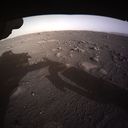Mars once featured an ocean with "vacation-style" beaches, study suggests
Mars once featured sun-soaked, sandy beaches with gentle, lapping waves from an ancient ocean, a new study suggests.
Why it matters: The research marks the "clearest evidence yet" that the Red Planet once contained a major body of water and a more livable environment for life, per a statement from study co-author Benjamin Cardenas, assistant professor of geology at Pennsylvania State University.
- "When we look back at where the earliest life on Earth developed, it was in the interaction between oceans and land, so this is painting a picture of ancient habitable environments, capable of harboring conditions friendly toward microbial life," Cardenas said.
Driving the news: A team of Chinese and U.S. researchers identified hidden layers of rock under Mars' surface that strongly suggested the presence of a past northern ocean while analyzing data from China's Zhurong Mars rover, according to the study, published Monday in the Proceedings of the National Academy of Sciences.
- Zhurong sent back data in 2021 while searching for signs of ancient water or ice after landing in an area known as Utopia Planitia.
What they found: The scientists discovered "extensive dipping deposits in the subsurface" of this area, the study notes.
- Analysis of radar data indicated "foreshore deposits" similar to beaches on Earth with sediments.
- The research indicates the presence of "coastal sedimentary deposits formed by ancient ocean waves and possibly composed of sand and pebble gravels transported by tidal currents," per the study.
- Cardenas said this "stood out to us immediately because it suggests there were waves, which means there was a dynamic interface of air and water."
- Contributing author Michael Manga, a University of California, Berkeley, professor of Earth and planetary science, said in a statement the research showed "classic indications of sloping, sandy beaches lining an ocean."
Zoom in: Manga said the "sand that's on those beaches is coming in from the rivers, and then it's being transported by currents in the ocean and continually being transported up and down the beaches by the waves coming and going up and down the beach."
- He noted that Mars has many features that resemble ancient rivers. "So there must have been rivers transporting sediment to the ocean, though there's nothing in the immediate vicinity that would have disturbed these beach deposits," Manga added.
The bottom line, via Cardenas: "We're finding places on Mars that used to look like ancient beaches and ancient river deltas.
- "We found evidence for wind, waves, no shortage of sand — a proper, vacation-style beach."
Between the lines: Aaron Cavosie, a planetary scientist at Curtin University in Australia, said the find marked an "extraordinary contribution" to research into water on the Red Planet, per the Australian Broadcasting Corporation.
- "There is abundant evidence from orbital images and mineral mapping that surface water was present during the Noachian period from 4.1–3.7 billion years ago," added Cavosie, who was not involved in the study.
- "Its origin and duration continue to be debated."
Go deeper: Setting up the next scientific era on Mars





















